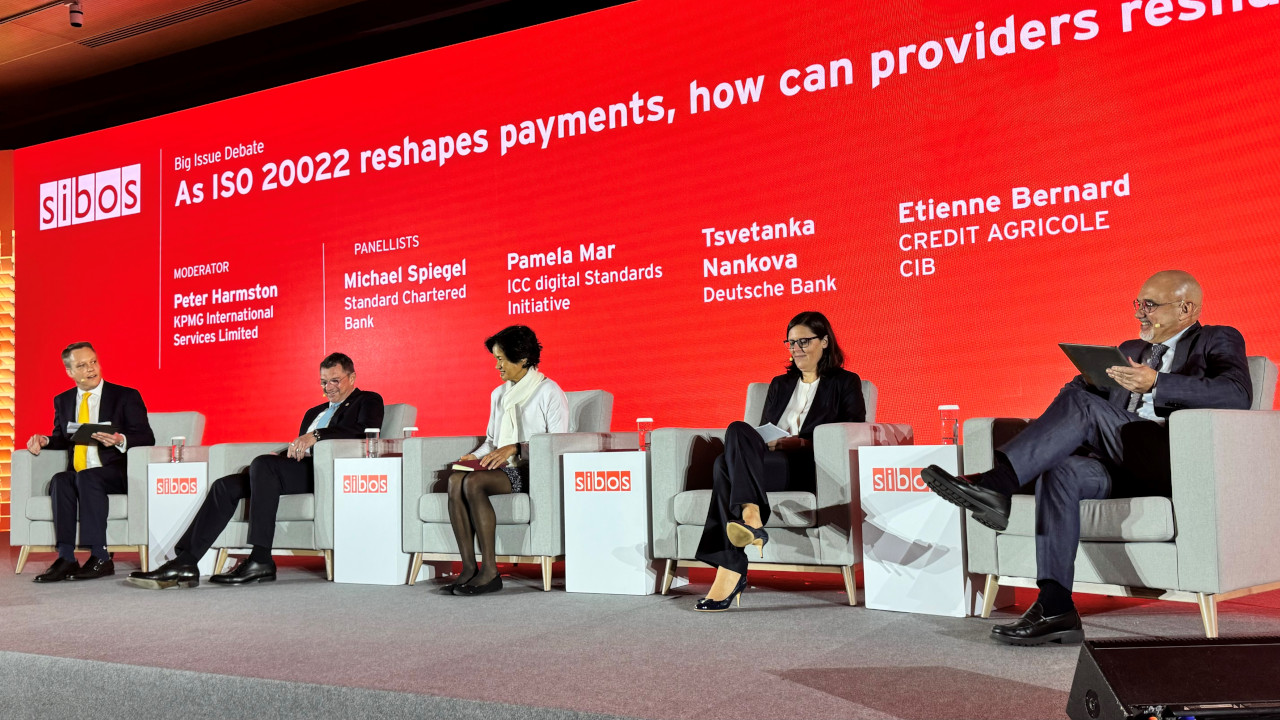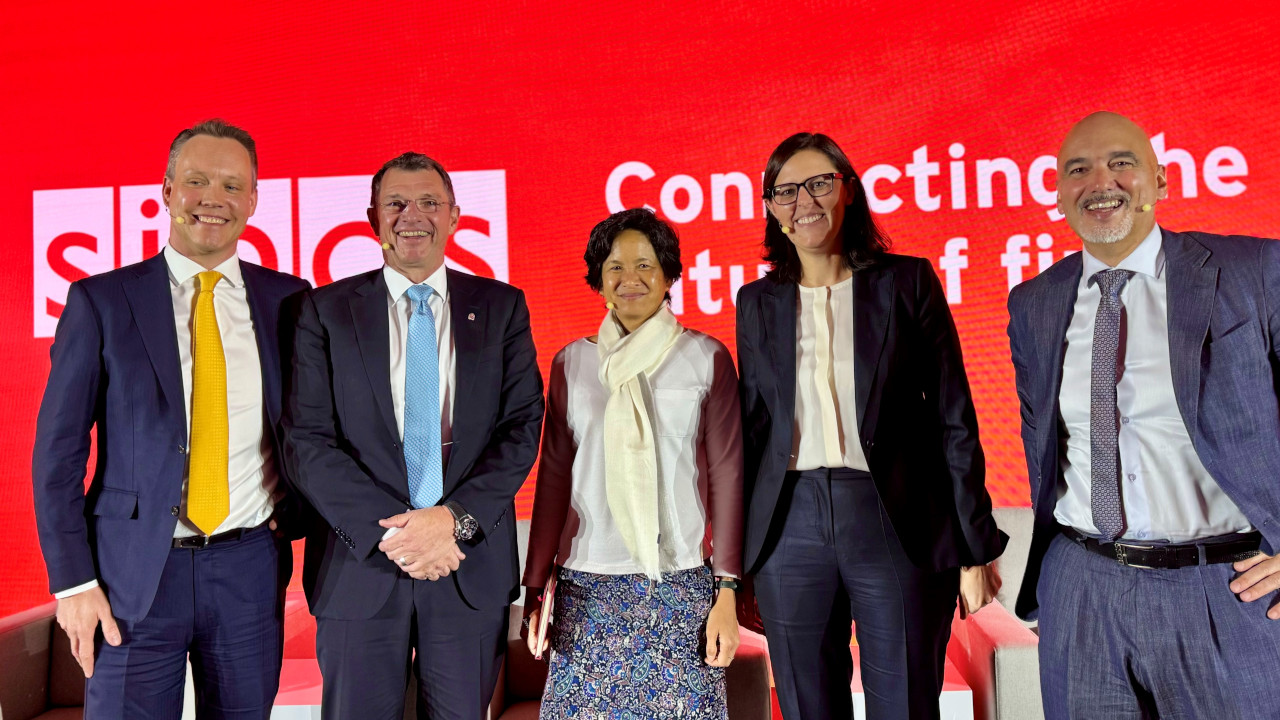07 November 2024
ISO 20022 has the potential to deliver the rich data needed to unlock trapped liquidity, finance trade that could not previously be reached, and deliver huge operational efficiencies. But what is holding back full adoption and how can the Swift community work together to accelerate it? flow’s Clarissa Dann shares answers from the Sibos 2024 Big Issue Debate on Day Three
MINUTES min read
To connect the future of finance – the theme of this year’s Sibos – ISO 20022 is the lynchpin creating an interoperable ecosystem for payments and trade. The new global standard for payment messaging replaces the MT messages maintained by Swift for cross-border payments, as well as the disparate proprietary messages used by market infrastructures in the high-value payment space. The brave new world is where an entire payment industry speaks a common, universally accepted language when transacting across borders.
This backdrop set the scene for the big issue debate at Sibos 2024 in Beijing – titled “As ISO 20022 reshapes payments, how can providers reshape themselves?” – on Day Three, which saw a lively discussion between a panel of experts, with representatives from Deutsche Bank, Standard Chartered, Credit Agricole and the International Chamber of Commerce (ICC).

From left to right: Peter Harmston, Partner, KPMG International Services Limited (Moderator); Michael Spiegel, Global Head of Transaction Banking, Standard Chartered; Pamela Mar, Managing Director, ICC Digital Standards Initiative; Tsvetanka Nankova, Global Head of Sales, Institutional Cash and Trade Finance, Deutsche Bank; and Etienne Bernard, Global Head of Cash Management, Credit Agricole. Photo © Deutsche Bank
Some way to go
When Swift introduced ISO 20022 to its network in March 2023, it kicked off a co-existence period during which the existing MT standard has remained available alongside the new standard. In November 2025 this co-existence is set to end, after which all payment messages sent or received via the Swift network must be based on ISO 20022.
“With the launch of the new standard we do have significant structured new data made available to us”
While just over a year remains until this landmark date, Swift has revealed that the current adoption rate for cross-border payments stands at only 27% and one recurring discussion point at this year’s Sibos was community readiness. While the adoption rate remains below expectations, there is reason for optimism. In April 2024, Swift asked 175 financial institutions on its network whether they would meet the November 2025 deadline. All indicated that they were on track, which if correct would represent a shift of 86% of cross-border instructions to ISO 20022.1
Though progress is, in theory, on the right track, getting as close to as possible to 100% adoption will be critical in reaping the full benefits of the new standard given that banking is a network business. Tsvetanka Nankova, Global Head of Sales Institutional Cash and Trade Finance, Deutsche Bank opened the discussions by sharing the benefits of being live on the standard. “We are seeing a significant improvement in straight through processing ratio of transactions. This provides significant speed to the processing from an internal point of view and enables faster payments for our clients. There has also been a significant reduction in the false positive hits when it comes to the sanctions screening of transactions, which allows us to focus on potential positive hits and ultimately fosters better risk management.” She added, “With the launch of the new standard we do have significant structured new data made available to us and how we make use of it going forward is all up to us as institutions.”
However, achieving scale is easier said than done. Adopting ISO 20022 still poses significant challenges, continued Nankova. “When it comes to the cost of the adoption of ISO for payments, a lot of the big banks can absorb the costs. Potentially, the reason that we have a slower adoption is because some of the smaller financial institutions are struggling. This is a costly exercise that requires a lot of internal change.”
All aboard?
According to Etienne Bernard, Global Head of Cash Management and Regional Head of Europe at Credit Agricole CIB, “it’s all about the efficiency of the operating model,” which, when got right, creates “a beautiful circle”. As November 2025 nears, he sees 27% adoption as “far too low” which is “a real concern if you want to be efficient”. Having gone live on the standard in India, one particular benefit that has emerged is “there is a lot of information available, so if there is a claim or some other issue, it is much easier to look at the data”. Later in the panel discussion, he added that proving the benefits of ISO 20022 adoption internally and externally to the customers banks service was “worthwhile”.
“We can use ISO 20022 to bridge between traditional and decentralised finance”
“We see a very large number of payment service providers native on ISO 20022 and also quite a lot of coin providers,” said Michael Spiegel, Global Head of Transaction Banking, Standard Chartered Bank. They include Circle’s USDC, and Ripple’s XRP. He added, “We can use ISO 20022 to bridge between traditional and decentralised finance. When you then take the rich data into that and combine it, you have almost the perfect innovation system,” developing a point Nankova had made that ISO 20022 adoption really had to be looked at “in conjunction with new technologies.”
“I will say that a large number of large multinational companies are already preparing or are prepared, there is, however, a much larger universe out there that still needs to prepare,” continued Spiegel. Technically, corporates are not obliged to move to the standard, but any failure to do so creates huge friction. From November 2026, when the use of structured addresses will become mandatory, corporates will need to provide ISO-compliant beneficiary address details, which is likely to bring changes in how they extract information from their enterprise resource planning (ERP) or treasury management systems (TMS).2
Today, the majority of ERP and TMS platforms do not maintain counterparty data in a way that meets the structured address requirements outlined by Swift. Making the necessary changes to update existing and legacy systems as well as resourcing the transition project, requires significant investment and organisational commitment.3 “It is not as simple that you can just click a switch and you agree to adopt a new format – platform transformation takes time,” said Spiegel.
But the pain has got to be worth it for corporates, agreed the panel. Reprising Bernard’s theme of proving the benefits, Nankova explained, “With payments becoming faster, you have an opportunity to unlock trapped liquidity. What we know from the corporate treasurers is that they still have a lot of liquidity sitting in idle cash that allows these institutions to start thinking about better and alternative investment solutions. In addition to this, with the better data you can improve reporting, reconciliation processes, you can do cash flow forecasting, data driven treasury, and you can enable scheduled payments. So literally, the sky's the limit.” None of this should be done in silos, she added, and a provider should “always have the customer in mind in terms of their expectations and the problems they are trying to solve”.
Beyond payments
Turning to the role of ISO 20022 in facilitating trade and cross-border payments with richer data, the panel agreed that there was a huge opportunity to accelerate its digitalisation – particularly in supply chains. But, as Nankova put it, “Trade is so much more complex. The whole value chain is so much longer. In trade the more you can structure the data, the faster you will process the transaction, the faster you unlock the liquidity, and you can ultimately recycle it. In terms of vision, we all see the benefits – but this complexity makes ISO 20022 a heavy lift.”
Nankova and Spiegel identified the main issue being around regulatory harmonisation when it came to participants assessing the validity of trade documents. “If you want to get your shipment off a ship in Dhaka you cannot use an electronic bill of lading as it is not written in local law. Even if the seller and buyer are agreeable, the harbourmaster cannot give it to you. ISO gives us rich data and we have the technology, but it is the actual writing into local law that is hindering us,” said Spiegel. “In the end, we are providing solutions to corporates to facilitate commerce and trade and payments across the globe. And from an adoption perspective, we already have around 35% adoption of our cross-border payments on ISO 20022, and we need to do a lot more.”
Pamela Mar, Managing Director, ICC Digital Standards Initiative, believes that governments need to update their regulatory frameworks to support trade digitisation. “It is a complex process that takes two to three years, but it is manageable if you break it down into bits,” she explained. “We are addressing that problem. The momentum this year is very visible. We need to recognise companies that have adopted standards that are not interoperable need a solution from their back end that is generating trade data to the trade platform which is where data is exchanged. We need to bring ERP providers, infrastructure providers, and fintech providers together. We need to make standards more accessible and simpler so that SMEs can easily enter global trade.”
With global trade having developed on the basis that competitive advantage lies in knowing where information arbitrage lies (“You have access to information that is not available to someone further downstream”), a mindset shift is called for, Mar believes. “We need to enter the era where we share data and help all the supply chain players understand that their competitive advantage is opening a part of their books, and that will not compromise their trade and will be an asset.” All the suppliers currently give their information to the buyer but now we are in an era where the buyer has to give some information. Then everyone in the chain can see where the good is, who is producing value and who is gaining.”
Collective commitment
Given the overwhelming support from the panellists for the new standard, the session’s moderator, Peter Harmston, Partner at KPMG International Services Limited, asked, “Is the combination of ISO 20022 and Swift really the only option to drive global interoperability?” In other words, are there any realistic alternatives to the scale and ubiquity of the standard?
“I think ISO and Swift will continue to dominate,” said Nankova. “Sometimes, when I think about this, I don't ask myself, Is there an alternative to ISO? Is there an alternative to Swift? I go one step further, and I think there are discussions about the settlement of transactions on the blockchain, so I do think that there will be emerging alternatives. Again, the question that always comes to mind is, will they scale? Because for everything to work, you basically require that whole network to be on board.”
Spiegel circled back to his earlier point that most payment service providers and DLT-based real-time gross settlement (RTGS) systems are already on the standard. “I don't think that we should even consider an alternative to ISO 2022. If we allow that discussion, we're never going to get anywhere. This is the standard we have agreed on and we have got to drive it forward,” he said. As for Swift (which he said was a separate discussion from standards), “this is a wonderful network of networks, and we welcome more participants. There will be alternatives that are complementary, and we all have a role to play. You need to connect everyone, and it only works if you connect everyone.”
Mar agreed. “Swift has demonstrated that it could interoperate an e-bill of lading between two different networks. We should be trying those innovations more and more to demonstrate that Swift could be useful to the non-financial world operating through finance.” She went on to point out that AI could be used to “bridge the gap between non-standard and standard data, or “structured and unstructured data”.
“We need to fight for ISO 20022 altogether, not only for the standardisation aspect, but to ensure we populate these messages with the right data, which is really going to make the value of the usage,” agreed Bernard.
In closing and having agreed “let’s get this done” in terms of adoption, the panel were optimistic about the future – and the potential solution to what Spiegel termed, “the deep-tier supply chain challenge”.
“There’s trillions of dollars unlifted because SMEs don't get financing. Technology has been there, but the format's not been there. The rich data has not been there. So, yes, absolutely, the future is bright, and it will have to build on us completing ISO 20022, create this connectivity global, create the rich data global, so that everybody can benefit,” he concluded – with the rest of the panel nodding in agreement to thunderous applause.
The takeaway from this panel was that the Swift community has a collective duty to make ISO 20022 happen for the sake of financial inclusion and trade finance gap reduction – as well as the benefits to each participant.

Photo © Deutsche Bank



